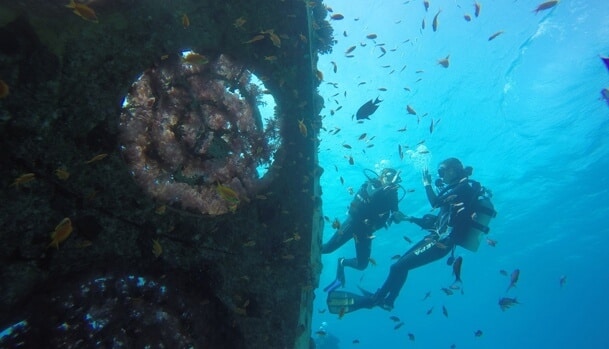Researchers from Ben Gurion University followed divers in Eilat for 15 years and found that the placement of the artificial reef reduced the pressure of diving on the natural reef

Drifting sand, touching, hitting with equipment, breaking, scaring fish, even if unintentionally, cause a lot of damage to the coral reef in Eilat. Researchers from Ben-Gurion University of the Negev followed divers in the Eilat reef for 15 years and found that its placement reduced the pressure of diving on the natural reef. The research findings were published in the journal Oceans.
Divers are tourists who love the coral reefs and enjoy watching them. They invest a lot of effort and resources in order to enjoy the diving and the reef, but unfortunately they also cause damage to corals, such as: floating sand, touching, hitting with equipment, breaking, scaring fish, even if unintentionally, cause a lot of damage to this natural treasure.
In Eilat, the pressure of divers on the coral reserve was detected many years ago and therefore already in 2006 an artificial reef was established. This reef was actually a means of diverting diving pressure from the natural reef to alternative sites, to maintain the boundary of the reserve, thus protecting both diving tourism and the coral reef. The laboratory of Prof. Nadav Shasher from the marine biology and biotechnology program of Ben-Gurion University of the Negev, The Nature and Parks Authority and the OBS company for underwater structures teamed up to establish the artificial reef at that time in 2006.

"I had an argument with the director of the Eilat district of the Nature and Parks Authority at the time, Guy Ayalon, about whether there was room for a significant artificial reef at the border of the reserve. He claimed that yes, I - that there is no room. We arranged to meet in the water and indeed he was right. Together we located a sandy place that is right on the northern border of the coral reserve and is suitable for the establishment of an artificial reef," said Prof. Shasher.
In 2007, corals grown in a special coral nursery were planted on the artificial reef and since then many corals grow naturally on it, many species of reef fish and other invertebrates that are difficult to meet in the natural reef can be observed there, such as: fancy nozzle fish, colorful soft corals and even giant snakes who go out at night to filter plankton, a group of organisms that drift in the water currents.
Prof. Shesher remembered the discussion that led to the establishment of the reef, and decided to investigate and closely monitor the movement of introductory dives (dives limited to a depth of 8 meters led by a qualified guide and for 20-40 minutes) before and after the placement of the reef, in order to empirically document its effectiveness. More than a decade after the deployment of the artificial reef, it was proven that the reserved area was able to cause a change in the paths of familiarization dives and there was a behavioral change among the divers. This fact helps preserve the natural coral reefs. 
A diving instructor and his apprentice near the artificial reef Photo: Dr. Jenny Tiniakov
"While before its installation, the introductory dive instructors had to lead their trainees into the reserve in order to enjoy the diving, after its establishment it became a magnet for divers, especially for guided dives and introductory dives," explained Prof. Shasher.
Starting in 2007, introductory dive visits to the body of the coral reserve were almost completely stopped since the artificial reef became a convenient and attractive diving attraction. In light of this, the attractiveness of the artificial reef was maintained even 15 years after it was placed, thus deciding the question of whether an artificial site would be attractive.
This research (No. M25-069) was supported by the Middle East Cooperation Fund MERC.
More of the topic in Hayadan:
- The coral reef in Eilat is still withstanding the rising sea water temperature, the question is until when
- Clean under the water and above the water
- The coral reef in Eilat is in real danger
- Even in Eilat Bay, corals begin to bleach and die
- The collapse of the coral reef in Eilat worsened because of the storm in 2020; Extinction of marine species and increase in sea temperature
